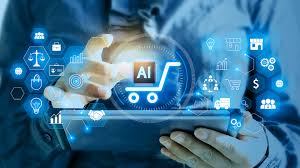
Introduction
Over the past two decades, e-commerce has shifted from being a convenient alternative to traditional shopping into one of the fastest-growing sectors of the global economy. From giants like Amazon and Alibaba to small independent online stores, digital commerce has reshaped the way people buy and sell. According to recent industry reports, global e-commerce sales surpassed $6 trillion in 2024 and are expected to continue rising.
But behind this rapid growth lies an even more significant transformation: the integration of Artificial Intelligence (AI) and automation. These technologies are no longer futuristic concepts; they are real-world tools changing the way businesses operate, interact with customers, and manage supply chains. AI is helping businesses deliver personalized experiences, while automation is making operations faster, cheaper, and more efficient.
In this article, we will explore how AI and automation are shaping the future of e-commerce, the opportunities they bring, the challenges they create, and what the next decade of online business might look like.
The Rise of AI and Automation in Business
Artificial Intelligence refers to computer systems that can perform tasks normally requiring human intelligence, such as problem-solving, learning, and decision-making. Automation, on the other hand, involves using technology to perform tasks with little or no human intervention. When combined, AI and automation are creating a powerful force that is transforming industries worldwide, with e-commerce being one of the biggest beneficiaries.
AI in e-commerce is mainly used for customer engagement, data analysis, recommendation systems, and marketing.
Automation in e-commerce often deals with logistics, order fulfillment, chatbots, and workflow processes.
These technologies are not only reducing costs but also enabling businesses to scale quickly and serve customers in more efficient and innovative ways. For instance, Amazon’s recommendation engine—powered by AI—generates 35% of its total revenue by suggesting products based on customer behavior. Similarly, warehouse robots and automated inventory systems have made it possible for online retailers to fulfill millions of orders daily without major delays.
Personalized Shopping Experiences
One of the most noticeable impacts of AI in e-commerce is personalization. Customers today expect more than just an online catalog; they want a shopping experience tailored to their preferences. AI-driven recommendation systems make this possible by analyzing browsing history, purchase patterns, and even social media activity to predict what a customer is most likely to buy.
For example:
Netflix uses AI to recommend shows and movies. Similarly, online retailers suggest products.
Amazon customizes its homepage for each user, showing items they are most likely to purchase.
Fashion retailers use AI to provide virtual fitting rooms, allowing customers to “try on” clothes digitally before buying.
Personalization not only improves customer satisfaction but also boosts sales. Studies show that businesses using AI-powered personalization experience up to 20% higher conversion rates.
This trend will only grow stronger as AI becomes more sophisticated, enabling businesses to predict needs even before customers consciously realize them.
Chatbots & Virtual Assistants in Customer Service
Customer service is another area where AI and automation are making a huge impact. Traditional customer support systems often involved long waiting times, repetitive queries, and limited availability. AI-powered chatbots and virtual assistants have changed this dynamic completely.
24/7 Availability: Unlike human agents, chatbots can operate around the clock, providing instant responses.
Cost-Effectiveness: They reduce the need for large customer support teams, cutting operational expenses.
Consistency: Chatbots provide uniform answers, ensuring no customer receives incomplete or inaccurate information.
Multilingual Support: AI assistants can communicate in multiple languages, expanding global reach.
For instance, Sephora’s chatbot helps customers find beauty products, provides makeup tutorials, and answers common questions. Similarly, H&M uses chatbots to guide shoppers through its catalog.
The future of chatbots lies in voice integration and emotional intelligence. As AI becomes better at understanding human emotions and natural speech, chatbots will evolve into digital companions that can handle complex queries and provide a truly human-like shopping experience.
Leave a Reply